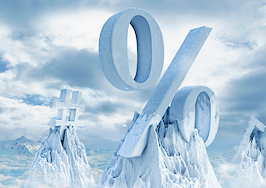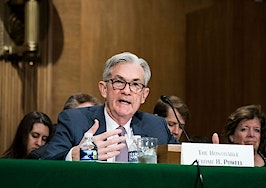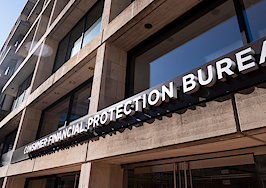The Federal Reserve will double the pace of its tapering of support for mortgage markets, as falling unemployment and worries about inflation outweigh uncertainty around the potential health and economic impacts of the Omicron variant.
Under a schedule announced in November, the Fed had planned to trim the $120 billion in monthly asset purchases it’s been making during the pandemic to keep interest rates low by $15 billion a month. That would have put the Fed on track to wind down its asset purchases by June.
At the conclusion of a two-day meeting, Fed policymakers Wednesday voted unanimously to double the pace of tapering, to $30 billion a month, a timetable that would end the Fed’s asset purchases in March.
“With progress on vaccinations and strong policy support, indicators of economic activity and employment have continued to strengthen,” Fed policymakers said in a statement. “The sectors most adversely affected by the pandemic have improved in recent months but continue to be affected by COVID-19. Job gains have been solid in recent months, and the unemployment rate has declined substantially.”
During the pandemic, the Fed had been increasing its holdings of long-term Treasurys by $80 billion a month, and adding $40 billion a month to its stockpile of mortgage-backed securities.
In November, Fed policymakers agreed to start trimming those purchases by $10 billion a month for Treasury securities, and $5 billion for mortgage-backed securities.
Now the Fed plans to accelerate tapering and reduce the monthly pace of its net asset purchases by $20 billion for Treasury securities and $10 billion for agency mortgage-backed securities.
In January, the Fed will increase its Treasury holdings by $40 billion, and by $20 billion for mortgage-backed securities. That’s half the pace employed during the pandemic.
If Fed tapering continues at that pace, as anticipated, the Fed would buy $20 billion in Treasurys and $10 billion in mortgage-backed securities in February. In March, other than replacing existing bonds as the mature, the Fed’s pandemic relief for mortgage markets will end.
After release of the Federal Open Market Committee’s statement, 10-year Treasury yields — considered a barometer for mortgage rates — surged, as markets digested the Fed’s plans speed up its exit from bond markets.
“We are phasing out our purchases more rapidly because with elevated inflation pressures and a rapidly strengthening labor market, the economy no longer needs increasing amounts of policy support,” Federal Reserve Chair Jerome Powell said at a press conference following the meeting. “In addition, a quicker conclusion of our asset purchases will better position policy to address the full range of plausible economic outcomes. We remain prepared to adjust the pace of purchases if warranted by changes in the economic outlook. And even after our balance sheet stops expanding our holdings of securities will continue to foster accommodative financial conditions.”
Speaking before the Senate Banking Committee in November, Powell said the emergence of the Omicron variant does pose “downside risks to employment and economic activity and increased uncertainty for inflation.”
This week, World Health Organization Director Tedros Adhanom Ghebreyesus warned that the Omicron variant “is spreading at a rate we have not seen with any previous variant,” and that WHO is “concerned that people are dismissing Omicron as mild.”
Even if Omicron does cause less severe disease, the sheer number of cases could once again overwhelm unprepared health systems, he said.
But prices for U.S. consumer goods are up 6.8 percent over the last year — the fastest increase in any 12-month period since 1982, according to Consumer Price Index numbers released Friday.
“Like most forecasters we continue to expect inflation to decline to levels closer to the 2 percent longer-run goal by the end of next year,” Powell said.
“We understand that high inflation imposes significant hardship especially on those least able to meet the higher costs of essentials, like food, housing and transportation,” he said. “We are committed to our price stability goal. We will use our tools both to support the economy and a strong labor market and to prevent higher inflation from becoming entrenched.”
Improvements in job markets give policymakers leeway to accelerate tapering, Powell said.
“Amid improving labor market conditions and very strong demand for workers the economy has been making rapid progress towards maximum employment,” Powell said. “Job gains have been solid in recent months averaging 378,000 per month over the last three months. The unemployment rate has declined substantially, falling 0.6 percentage point since our last meeting and reaching 4.2 percent in November.”
The recent trends “have narrowed the differences in employment across groups, especially for workers at the lower end of the distribution as well as for African Americans and Hispanics. Labor force participation showed a welcome rise in November, but remains subdued, in part reflecting the aging of the population and retirements.”
Powell has said that he wanted to see the Fed finish tapering before raising short-term interest rates — a move that the Fed could now implement as soon as March.
Asked if the Fed would pause between tapering and raising short-term interest rates, as it did in 2014, Powell gave no assurances that would be the case.
“I don’t foresee that there would be that kind of very extended wait at this time,” Powell said. “The economy is so much stronger. I was here at the Fed when we lifted off the last time and the economy is so much stronger now, so much closer to full employment. Inflation is running well above target and growth is well above potential. There wouldn’t be the need for that kind of long delay. Having said that, we’ll make this decision in coming meetings, and it’s not a decision that the [Federal Open Market Committee] has really focused on yet.
The Fed’s quarterly Summary of Economic Projections shows most policymakers on the committee are expecting three 0.25 percentage point increases in the short-term federal funds rate next year.
Forecasters expect mortgage rates to increase next year, but diverge on how sharply they’ll rise. Before the Fed announced its new timetable for tapering, Fannie Mae economists were projecting mortgage rates would average 3.4 percent during the final three months of 2022, while economists at the Mortgage Bankers Association expected them to hit 4 percent.
Get Inman’s Extra Credit Newsletter delivered right to your inbox. A weekly roundup of all the biggest news in the world of mortgages and closings delivered every Wednesday. Click here to subscribe.

























